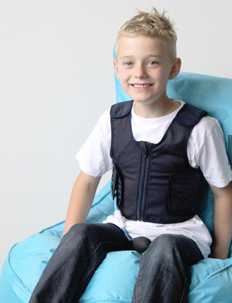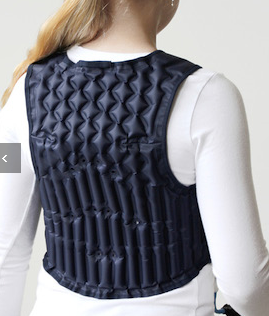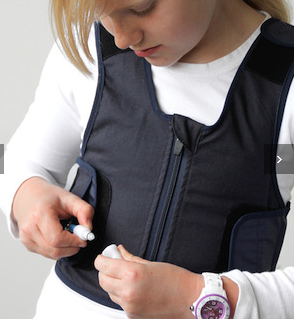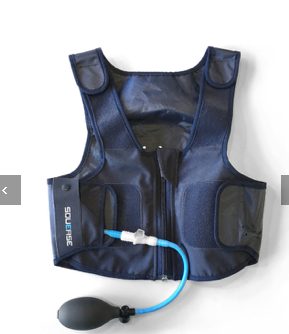antecedentes acerca del uso de sensorial devices en niños ASD
- ANNEGRET
- 5 sept 2022
- 4 Min. de lectura
Actualizado: 23 sept 2022
https://napacenter.org/weighted-vest-autism/
Weighted Vests and Autism: What You Need to Know
First and foremost, the use of a weighted vest with a child on the Autism Spectrum is merely a tool in the toolbox. Children with Autism Spectrum Disorders (ASD) often have difficulty processing and integrating sensory information throughout their day. It is important to work with an occupational therapist to explore a number of sensory motor strategies to help your child achieve their goals and access their environment more independently. The use of a weighted vest in pediatric occupational therapy practice may or may not be a tool that helps meet your child’s sensory needs but is likely worth exploring.
What is a Weighted Vest?
A weighted vest is a wearable garment with the capability of holding weight, typically a vest with sewn internal pockets where small ½ or ¼ pound weights can be placed. The weight and compression delivered by the vest provides proprioceptive input using deep pressure to the muscles and joints which sends signals to the brain helping a person feel calm and focused. On a potentially relatable level, it resembles a firm hug, without the emotional connotations!

There is no harm in trying a weighted vest on a toddler or child who has ASD. However, it is important to be working with an Occupational Therapist who has evaluated your child and can provide additional support through exploring this tool. Below are some tips to ensure the safety and comfort of your child while wearing this kind of vest.
Start light and slowly increase weight! The vest should end up being no more than 5-10% of child’s body weight. If your child weighs 50 pounds, then the vest should be no more than 5 pounds.
The weight should be evenly distributed throughout the vest, around the midsection (pockets sewn on the interior circumference of the vest with ability to add/remove weight when needed) and the vest should be snugly fit to your child’s body.
Avoid habituation: have your child wear the vest for no longer than 15 minutes at a time. Following approximately 15 minutes of wearing, a child will habituate to this newly imposed sensory input and it will no longer be an effective tool.
Schedule 2-3x per day (one morning, one afternoon) for no more than 15 minutes per wearing schedule.
Keep in mind that removing the vest is just as much of a sensory experience as donning it in the first place. So directly after wearing, you will likely see a benefit as well and then your child will again, get used (habituate) to the feeling without the weight of the vest.
Choose timing of wear schedule wisely. It is most appropriate and effective to implement the use of the weighted vest during times where your toddler or child may be completing activities such as school work, crafts, eating, playing games requiring communication (utilizing AAC devices to engage during family game time), etc. as these tasks require increased attention/ focus. Having your child wear the vest during times where they are passively watching TV or using devices would not be beneficial.
Wearable Therapeutics (formerly known as Squeezease Therapy Inc.)
Snug Vest Is Therapeutic
Your child’s personal hug. Does your child feel restless, anxious or over-stimulated? The hug-like pressure gives a calming, safe and secure feeling.
This lightweight, inflatable pressure vest is suitable for children aged between 4-7 (size XXS) and 7-10 years old (size XS). Each vest comes with a hand pump and pump release valve. The pump release valve allows you to remove the hand pump, while the vest is inflated.
The kids’ vests have a different design to the larger vests, with a soft fabric front, inflatable back and adjustable shoulder straps. The feeling of pressure is similar but the more flexible fabric front enables the kids to play and move more freely. The shoulder straps offer adjustability for a better fit around the shoulders.
Named after a form of sensory therapy that involves minimizing stimulus by providing the feeling of a firm hug, the Deep Pressure Therapy Snug Vest inflates and applies pressure to the body, which reduces the stress-causing hormones adrenalin and cortisol.

•Hood The quilted hood locks out light and other sensory distractions, which can cause over-stimulation in people with autism.
•Pressure-distribution strip An elastic strip down the centre expands as the vest inflates, minimizing pressure on the stomach and chest to facilitate breathing even at full inflation.
•Deflation tube The vest deflates by twisting the end of the deflation tube (the vest takes about 10 seconds to deflate); it is recommended that wearers deflate the vest after 20 minutes of use and take a 30-minute break before using it again.
•Inflation tube A hidden inflation tube is accessible through the right pocket and inflates with an attachable hand pump that allows wearers to pump the vest themselves.
•Vertical adjustment strip A Velcro strap lets wearers adjust the vest according to a user’s height. Vest sizes range from small enough for a three-year-old child to adult sizes.
•Pockets Found on either side of the vest, pockets provide added comfort and storage for the wearer—a must for people with autism who need to have personal belongings close at hand and easily accessible.
Este chaleco con peso para niños es perfecto PARA AQUELLOS que buscan estímulos sensoriales de presión profunda. La presión profunda y la retroalimentación propioceptiva ayudan a los niños a sobrellevar la sobrecarga sensorial. Los niños con autismo, TDAH y trastorno de procesamiento sensorial se beneficiarán del chaleco de compresión pesado.
















Comments